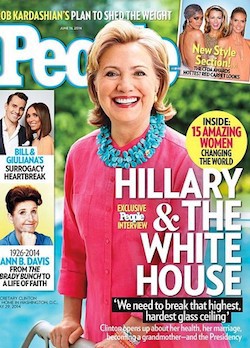What Time Is 2016?
What Time Is 2016?

The science of eras in an imperfect one, but it is not an art: It is simply hard to practice, because its defining quality — time — is superior to all others. The beginning of a historical period can rarely be pinpointed until it has passed; the end is often forgotten before it is ever determined.
For example! Political experts have been struggling with a particularly difficult question since at least 2011: When is 2016? Irrelevant old-timers insist that 2016 cannot start until 2015, but nobody has paid much credence to such stubborn contrarianism since 1992, which began in 1989. Eager young hotshots, using a mixture of traditional and theoretical methods, have suggested that 2016 actually began in 2012, in Benghazi.
These discussions are inconsequential as of June 4th, 2014, 1:20 p.m. EST. That is the time at which “Solved: People Magazine’s Hillary Clinton Cover Mystery” was published in the Wall Street Journal:
Hillary Clinton’s appearance on the cover of the People magazine raised some eyebrows Wednesday — and not for her comments on a potential run in 2016 or about Monica Lewinsky.
Instead, some Twitter commenters focused less on Mrs. Clinton’s words than on her hands. Due to the way the cover is cropped, the pose at first glance could resemble that of someone leaning on a walker.
There is some disagreement about when, exactly, June 4th, 2014, 1:20 p.m. EST itself began. The first mention of the pool chair’s resemblance to a medical device came at 7:01 a.m., from an advisor to Ted Cruz, on Twitter. But it was posted in response to a post, four minutes earlier, from Commentary editor John Podhoretz: “Correct me if I’m wrong, but kind of a creepy picture, no?”
I would suggest that neither 6:57 a.m. nor 7:01 a.m. are when the 1:20 p.m. era began, however. These tweets are simply making fun of an opponent; the whistles they blow are quiet and silly. Drudge came a couple hours later, which had an amplifying effect. But it seems more likely that 1:20 p.m. did not formally begin until 10:02 a.m., when New Republic Senior Editor Rebecca Traister posted on Twitter:
Psst, Hillary, when the photographer asks you to lean on something that might look like a walker or otherwise suggest infirmity, don’t do it.
This is the moment at which a partisan joke became a question of official optics, the appearance of which historically signifies the beginning of a new electoral era. It is not enough for a single event to become a story loaded with meaning — that is simply called narrative building, which increases in intensity and frequency during an election but which can be observed at any time. No, this stretched narrative must be imagined through the eyes of others, earnestly and with their ideologies. None of the aforementioned people, all media professionals, think that Hillary Clinton’s proximity to a walker-like object is a meaningful sign of anything at all. Any concern, feigned or real, is about how such imagery might play in front of other people.
In front of whom, though? This is the most important part: These optics-obsessed masses must not actually exist. This is a story that profoundly hates the people it is implicitly about, suggesting that they are both deeply concerned with politics yet profoundly unaware of its language. Which is fine, because these people are not available to be offended: They are too stupid, too easily swayed, and most of all too convenient to be real. The story’s actual audience, on the other hand, is in on the joke: They, too, speak the language of optics; they, too, don’t care that these optics are perceived by precisely nobody.
“Solved: People Magazine’s Hillary Clinton Cover Mystery” marks the first time, to my knowledge, that a 2016-related story has fully disengaged from the matter of the election of a new president and ascended to election season, that dreaded plane of noise, confusion and misery. Welcome to 2016! See you in five years, when it’s all the way over.
